
The legacy of the fight for the right to vote helped galvanize many of the people’s movements in the U.S., most especially the Civil Rights Movement of the 1950s and 1960s that culminated in the signing of the 1965 Voting Rights Act. We mourn and commemorate the countless Americans who gave their lives, were tortured, and risked death to extend and maintain the right to vote. These include African Americans lynched, Medgar Evers, Viola Liuzzo, Dr. Martin Luther King Jr., Fannie Lou Hamer, John Lewis, and so many others. We include in our priorities the work needed to continue extending voting rights.
At the same time, a galloping threat of far right-wing reaction on behalf of the ruling class is gathering. This threat endangers the ongoing fight for the U.S. as a republic of, by, and for the people.
At stake in the 2022 midterm elections is majority control of the U.S. Senate and House — both held now by razor-thin Democratic majorities. A gain of just one seat for the Republicans will make Mitch McConnell majority leader of the Senate again. A gain of just seven seats in the House will likely install Republican Trump boot-licker Kevin McCarthy as Speaker of the House.
Even now, thanks to the racist filibuster rule, McConnell has been able to use it to block Senate approval of the House-approved Build Back Better bill, the John Lewis Voting Rights Act, a measure to ensure abortion and health rights for women, and the Protecting the Right to Organize (PRO) Act.
If we lose the midterms, and Capitol Hill once again comes under Republican majority control, the ground will be set for ex–Oval Office resident Donald Trump to run for president again in 2024. This will mean a giant shift toward authoritarian rule — neofascism — in the U.S.
This threat is voter suppression, and IT AFFECTS YOU.
From coast to coast, in all but two states, right-wing politicians aided and abetted by the ruling class have introduced more than 400 pieces of legislation to make voting more difficult for progressive and Democratic-leaning and oppressed sectors of the population, whether Black, Latino, Asian, Native American, female, student, worker, incarcerated, disabled, single mom or a senior.
Voter suppression comes in many forms. The Transformative Justice Coalition lists 61 separate methods of repression. First on the list are so-called “Voter ID” laws. The U.S. Supreme Court’s Republican majority approved the first such modern-era law, from Indiana, in 2007. Six years later the justices opened the floodgates to wholesale voter suppression laws.
The same Supreme Court majority wiped out the “preclearance” sections of the 1965 Voting Rights Act. Preclearance sections mandated that jurisdictions with histories of race-based voter suppression first need federal approval before passing any voting law changes in their jurisdiction.
The Rev. William Barber II, co-chair of the Poor People’s Campaign, notes that on the very same day the Supreme Court eliminated preclearance, the Republican-dominated legislature in North Carolina took all of 45 minutes to pass a state-wide voter suppression law.
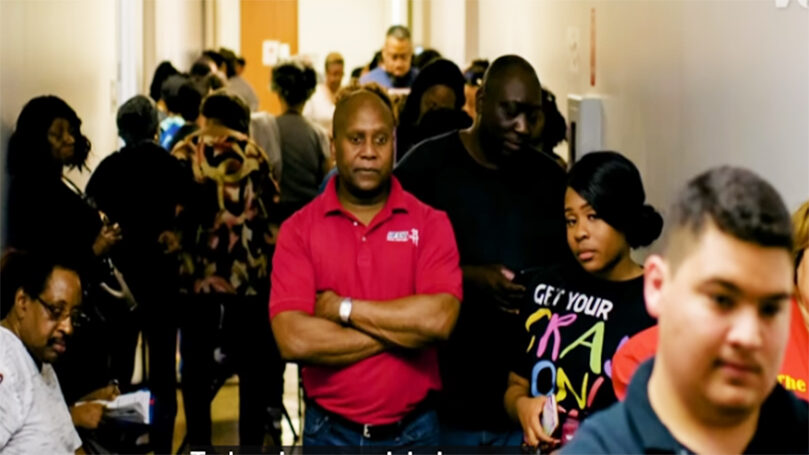
The last of the 61 measures listed by the Transformative Justice Coalition will be familiar to anyone who tried to vote in Wisconsin and Georgia in 2020, or in Ohio in 2004, especially in the area around Ohio State University in Columbus: long lines.
Other voter suppression measures voters faced in the March 1, 2022, Texas primary election:
- barring votes by mail
- imposing difficult registration rules
- limiting polling hours and days
- wholesale rejection of ballots
Not mentioned by the Justice Coalition: how repression in some states affects voters in all states.
The CPUSA has been in the forefront of battling voter repression and suppression from its founding over a century ago. We have a vested interest in expanding, not contracting the electorate. The ruling class, on the other hand, wants fewer people to vote because that makes it easier for pro-corporate candidates to win elections. Once the pro-corporate candidates are elected, the ruling class wields their political power to enact policies that favor their financial interests.
Conversely, the more people who vote, the better chance we have of electing officeholders who can block or overturn the ruling class’s laws and the better chance we have of advancing laws to help working-class people.
As our national co-chair Joe Sims told the party’s National Executive Committee in February 2022: “Make no mistake: The extreme right has its eyes on the prize of the midterm elections. One can only imagine what’s in store for the country should they win.”
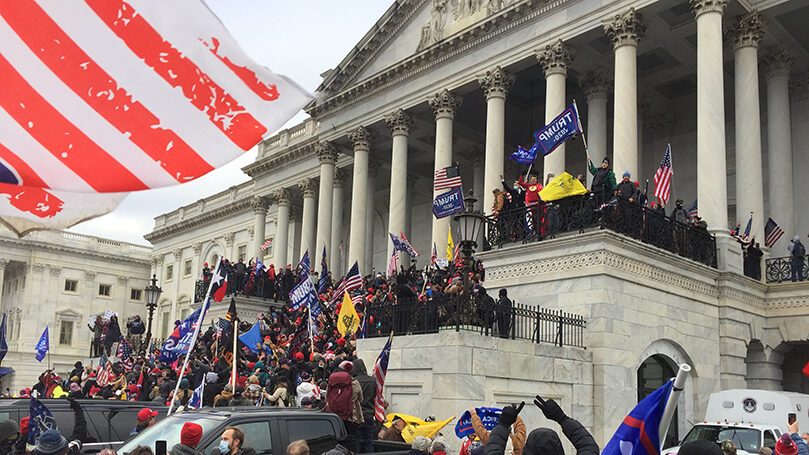
Comrade Sims went on to say,
Just what is the Republican Party becoming? Has it been completely captured by national chauvinists, authoritarians, white supremacists, and neo-fascists? Or does it remain a coalition with center-right forces and if so to what degree? . . . the National Committee of the GOP . . . declared that January 6th was ‘legitimate political discourse. . . . The Trump forces are now normalizing insurrection, normalizing counter revolution and armed right-wing revolt.
Voter suppression, repression, and intimidation are specifically designed to achieve by other means the aims of the Capitol insurrectionists of Jan. 6, 2021. You don’t need to invade Congress and the U.S. Capitol if you’ve already determined who sits in it or in the White House — and that’s what voter suppression ultimately does.
The Southern Poverty Law Center’s Michael Hayden says: “This hard-right faction, loyal to” former Oval Office occupant “Donald Trump . . . worked to systematically undermine democracy in the months following the attack by installing into positions of power loyal proponents of Trump’s Big Lie and by passing a flurry of voter suppression bills.”
But first some history.
Despite the high-minded words in the Declaration of Independence, that “All men [these days it would be ‘All people’] are endowed with certain inalienable rights,” remember that the right to vote was not one of those rights in 1776.
That year, in virtually all the colonies, voting, where it existed, was reserved for white men of privilege and property, often with wealth requirements which effectively barred even a majority of white colonists from voting. Rich planters in Tidewater Virginia could vote, while poorer white pioneers of its northwestern section — the Shenandoah Valley and what is now West Virginia — could not. Neither could Black slaves. Some states imposed religious tests, too.
As a result, the rich white elite ruled. Many of them were even dubious about the American Revolution or were outright supporters of British rule.
By fits and starts after independence from Great Britain, the franchise for the vote expanded, but with setbacks. Poorer white men gradually received the right to vote, with some restrictions that took a long time to eliminate. The 15th Amendment to the Constitution, ratified in 1870, extended the right to vote to Black men — but not to white women, women of color, or people serving prison sentences.
After the dismantling of the progressive Reconstruction era by a vicious backlash, the racist Southern elite reigned supreme in the Southern states, aided by violence and lynching. These regimes of terror yanked hard-won voting rights back from Black citizens. These same regimes throughout the South also banned voting by ex-prisoners, a majority of whom were Black. The same laws banning ex-prisoners from voting remain in effect even now.
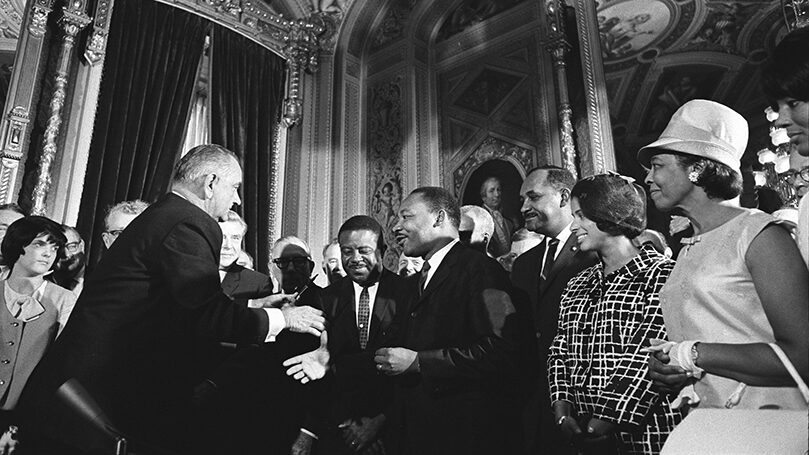 It took until the 1950s and the mid-1960s to gain meaningful progress for Black voters. This progress came about through three developments:
It took until the 1950s and the mid-1960s to gain meaningful progress for Black voters. This progress came about through three developments:
- The Supreme Court’s one-person one-vote decision in Baker v Carr (1962)
- Passage of the Civil Rights Act of 1964
- Passage of the Voting Rights Act of 1965
Baker v Carr required that legislative districts must be equal in population. Before then, the country’s urban residents, which included large swaths of residents of color, were relatively disenfranchised, compared to rural whites.
Texas and Georgia were the two worst examples of racially unbalanced and numerically unequal districts in the time before Baker v Carr. The Congressional Quarterly’s Guide to U.S. Elections reports that before Baker v Carr, Georgia’s Fifth District, which in 1962 included all of metropolitan Atlanta, had 823,860 people, while the rural Ninth District had fewer than one-third that number. Georgia had last redrawn its congressional district lines 31 years earlier, in 1931.
Women legally gained the right to vote in 1920, though Black women, in practice, were denied the right to vote in the South. Hispanic-named men and women were denied voting rights in the Southwest. Indigenous people theoretically gained the right to vote in the 1920s. In practice it was another matter. People aged 18–21 gained the right to vote in 1971.
The historic 1963 March on Washington, at which Dr. Martin Luther King Jr. made his famous “I have a dream” speech to 250,000 people at the Lincoln Memorial, was the kick-off of the Civil Rights Movement’s big push for extension of voting rights to more people.
Much of the funding and logistics for the march came from unions, specifically from the United Auto Workers and its fabled president, Walter Reuther. The leading Black union leader, A. Philip Randolph of the Brotherhood of Sleeping Car Porters, played a big behind-the-scenes role, too. Bayard Rustin was among the leading strategists.
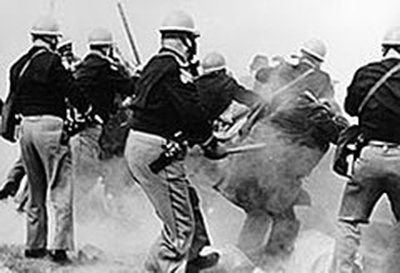 Two years later the Selma-to-Montgomery voting rights march was held, in 1965. Sheriff “Bull” Connor unleashed dogs and high-pressure water hoses on the peaceful marchers led by Dr. King and Randolph at his side.
Two years later the Selma-to-Montgomery voting rights march was held, in 1965. Sheriff “Bull” Connor unleashed dogs and high-pressure water hoses on the peaceful marchers led by Dr. King and Randolph at his side.
That commitment extends through the decades, all the way through the 2020 election and beyond.
Majority people of color service worker union Unite HERE suffered a 90% jobless rate among its members due to pandemic-driven closures of hotels, restaurants, and amusement parks. The union hired thousands of these newly unemployed members, trained them as organizers, and then sent them to key swing states and cities, with a special focus on communities of color.
Unite HERE and Stacey Abrams continued their organizing and get-out-the-vote (GOTV) efforts for the two post-election runoffs in Georgia. Jon Ossoff and the Rev. Raphael Warnock won narrowly there on Jan. 5, 2021, flipping both U.S. Senate seats in Georgia and lifting the Senate to its present 50-50 tie, placing Vice President Kamala Harris as the tie-breaking vote when the need arises.
Without Unite HERE, this wouldn’t have happened — and Georgia’s ruling Republicans have responded with repressive voting rights curbs. “Unite HERE didn’t listen to the pollsters” who said Georgia was still a red state, CP Political Commission Chair Joelle Fishman remarked.
As for the party’s role, “Our history suggests, as the National Committee knows, that the first thing that must be done when surrounded by fascist sharks is to cast a wide net — a net wide enough and strong enough to yank these sharks out of the water,” Joe Sims said. “That’s what the all-peoples electoral front and vote is: A net of collective action wide enough and strong enough to yank fascist sharks out of the water.
“Workers have to lead this effort,” Sims said later in his February 2022 address. “And where they’re not leading it, the Communist Party has to fight for such leadership.”
How tough will it be? Very tough. But it affects you and me, even if we don’t live and vote in repressive states such as Texas and Florida and the Carolinas.
The repressive measures include Texas’s recently enacted law, which mandates that a voter seeking an absentee ballot must sign the form exactly as she did when she first registered years ago, among many other requirements and restrictions.
The signature rule tripped up a 74-year-old woman in Houston before the state’s March 1, 2022, primary. She first registered 46 years ago, and told local ABC TV there was no way she could remember exactly how she signed her original registration form all those years ago.
Tens of thousands of Texas voters seeking to cast absentee ballots in the March 2022 primary lost their rights to vote — including 50% of absentee applicants in El Paso.
And on March 11, 2022, the Arizona Republican Party sued in state Supreme Court to completely invalidate early voting in the Grand Canyon State. Some 90% of Arizonans, in what is now a “purple” state, and which saw record turnout in 2020, vote early.
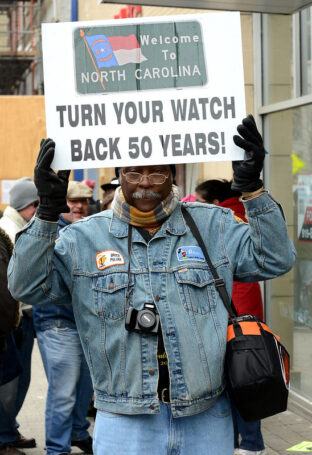 The Transformative Justice Coalition lists 60 other repressive measures. One measure is to close Department of Motor Vehicle offices in strict “voter ID law” states. DMV offices are where voters often obtain voter registration. Another voter suppression measure is discrimination against college students. Texas rejects college students’ IDs for voter registration but does accept gun permits as valid voter registration identification.
The Transformative Justice Coalition lists 60 other repressive measures. One measure is to close Department of Motor Vehicle offices in strict “voter ID law” states. DMV offices are where voters often obtain voter registration. Another voter suppression measure is discrimination against college students. Texas rejects college students’ IDs for voter registration but does accept gun permits as valid voter registration identification.
There are bans on early voting, fewer hours the polls are open, which makes it tougher for workers to vote, and punishment of voter registration projects and poll workers who try to curb zealous and intimidating private “monitors.” The monitors, meanwhile, get free rein.
Sunday voting is banned, thus eliminating Souls to the Polls, which Black churches often use. Voter roll “purges” use faulty lists. In Florida, there were orders to purge Hispanic-named voters. After 18 years of no problems, right-wingers in North Dakota, in legislation this year, banned Election Day voter registration.
When all else fails, the anti-voting right-wing moves the voting sites. Voters in Columbus, Ohio, can tell you all about the decision by right-wing, Secretary of State Kenneth Blackwell in 2004. He ordered a cut in polling stations at Ohio State University, disenfranchising students and people of color. The polling stations and machinery were shifted to the majority-Republican suburbs.
Voters in Kansas told a similar story in 2020: One Republican-run city there closed two of its three polling stations and moved the third to a strip mall at the edge of town with no access to public transportation. The city’s voters of color, of course, were more-frequent public transportation users.
Even non-repressive states have repressive aspects: As Tim Wheeler recently reported in the People’s World, the Washington state legislature is disenfranchising Spanish-speaking voters, especially farm workers, through redistricting. And lawsuits challenging New York City’s convoluted voter registration rules are moving through the courts. Comrades in Los Angeles, Calif., report there were considerably fewer polling sites and drop boxes in predominantly Latino/a precincts.
The most pernicious measure, however, disregards voters entirely.
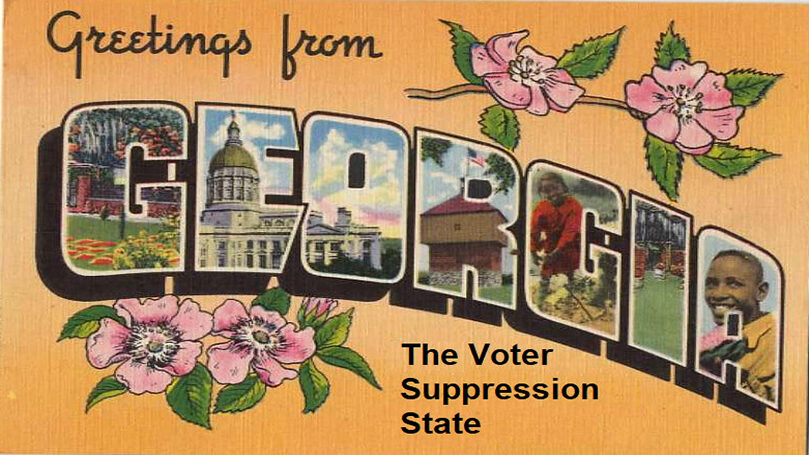
Georgia’s legislation, as well as a bill sponsored by a right-wing Republican lawmaker in Arizona — both using a model crafted by the American Legislative Exchange Council (ALEC), a secretive corporate cabal — would transfer the power to decide elections out of the hands of non-partisan poll workers and/or secretaries of state to partisan state legislatures. Don’t like the voters’ decision? Override them.
Even when these measures don’t pass, or even when the courts toss them out, such legislation still suppresses voters of color, women, poor people, youth, incarcerated, disabled, seniors, and progressives. That’s because many voters don’t find out beforehand that the courts ruled those measures invalid. So people shy away from registering, or, even if they are registered, they don’t vote.
The ruling class also targets some people of color whom they think they can swing to their side with cultural issues, especially in the South. The Republicans now take the white section of the working class — especially men — for granted.
Republican candidates pursue voters of color who may be culturally conservative on issues such as reproductive rights. They peel these voters away from progressive candidates who work to pass pro-working-class legislation.
The Republican wing of the ruling class doesn’t expect to win a majority of voters of color. Republican white nationalists don’t need or want that majority. All they need is just enough votes to swing close elections, by switching votes or by discouraging progressives from voting at all.
A form of voter suppression that potentially has a national impact is state gerrymandering of district lines for U.S. Congress and state legislatures.
The Republican tidal wave in the 2010 off-year election swept right-wingers into power from coast to coast. They gerrymandered with a vengeance, drawing absurdly convoluted district lines to effectively disenfranchise opponents of their repressive policies: People of color, women, students, seniors, the disabled, the incarcerated, progressives, workers, and Democrats in general.
These Republican lawmakers then extended their repression of the working class even further: They repealed pro-worker protections, curbed reproductive choice and rights, and cut jobless benefits, for example.
The worst example: Swing state Wisconsin, where Democrats historically receive 55% or more of the total vote for the state legislature, and won only around one-third of the seats, as a result of post-2010 Republican gerrymandering. The same majority passed a raft of anti-worker legislation, much of it written by the ALEC corporate cabal.
The most notorious of the Wisconsin Republican measures was the infamous Act 10, which completely trashed public worker unions in the very state where the American Federation of State, County and Municipal Employees was founded in the late 1950s.
In the aftermath of the 2020 national Census, Republicans have now redrawn district lines perpetuating corporate and rightist control for the rest of this decade, except in states with non-partisan redistricting commissions.
What’s less obvious is the impact on the whole country. Here’s what we’re talking about:
In Congress, deep red and deeply gerrymandered South Carolina has seven U.S. representatives: Six pro-corporate Republicans who vote in lockstep and its sole Democrat, House Majority Whip Jim Clyburn, who is Black. South Carolina is 27% Black, and the Black community there, by right, should have a second seat. The gerrymandered legislature ensures it does not.
On the other side of the ledger is “blue” state Connecticut, with five U.S. representatives, all Democrats. Like the rest of New England, Connecticut’s U.S. House delegation shifted from decades of rock-ribbed Republicanism to being solidly Democratic, as the national Republican Party moved in ever-repressive, racist directions.
But put the South Carolina and Connecticut state delegations together, and the six corporate white South Carolina Republicans cancel out the five Connecticut Democratic representatives and Clyburn. And since repressive “red” states, led by Texas and Florida, are gaining U.S. House seats while “blue” states like Michigan, Ohio, and Illinois are losing them, the repressive forces gain more power on Capitol Hill.
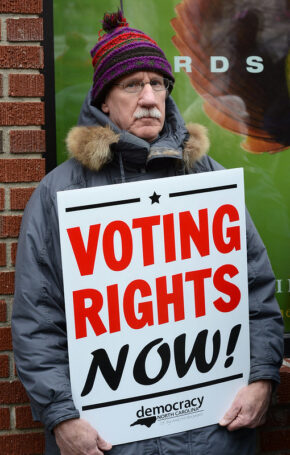 Indeed, Ohio is a prime example. While Ohio courts have intervened, the heavily Republican gerrymandered state legislature, faced with the loss of one congressional district, virtually obliterated the majority-Black district centered in Cleveland. An interactive map just posted online by the Washington Post shows the remaining district that includes much of Cleveland has a mild, 3%, Democratic tilt.
Indeed, Ohio is a prime example. While Ohio courts have intervened, the heavily Republican gerrymandered state legislature, faced with the loss of one congressional district, virtually obliterated the majority-Black district centered in Cleveland. An interactive map just posted online by the Washington Post shows the remaining district that includes much of Cleveland has a mild, 3%, Democratic tilt.
That makes voter repression in red states such as South Carolina or gerrymandered states such as Ohio a problem for blue states such as Connecticut, too — and the country as a whole.
What can we do about it? CPUSA Co-Chair Joe Sims, in his speech to the party’s National Committee, offered some ideas. The top one: “Collective unity of action” with “neighborhood associations, PTAs, lodges, women’s rights groups, and environmental organizations along with reaching out at grocery stores, bars, pool halls, barber shops, beauty salons, dry cleaners, and county fairs.
“And it’s sewn into an unbreakable thread by demonstrating, sitting in, and writing letters to the editors, outlining the issues and supporting candidates who back them — including when possible our own party candidates.”
We would add several others:
- Join a massive voter registration campaign (League of Women Voters, NAACP, Stacey Abrams’ groups Fair Fight and the New Georgia Project Action Fund, Common Cause, etc.) not just in your own states, but in voter-suppression states, to overcome the foes with numbers.
- If you can’t canvass in person — and in many states, voter-suppressive or not, you can’t unless you live there — the best, but not the only, instrument is the telephone. Next best is text banking.
- When you join a pro-voting campaign, make sure it has an education component, teaching voters how to remain legally registered. Recent elections have shown how voters are easily stripped of their rights through nitpicking by Republican-appointed elections officials.
- Work with groups of progressive lawyers who are starting to train to prevent voter intimidation at the polls, and to go into court to seek injunctions, when voter intimidation and suppression occur.
- Volunteer to be election judges, poll watchers, etc., to prevent the radical right from usurping all those positions.
And call your local branch of the CPUSA, or the national office, for information and advice.
Images: Voter Suppression Is Violence, cool revolution (CC BY-NC-ND 2.0); Long voting lines, Vox video, screenshot (YouTube); Jan. 6 riot, Wikipedia (CC BY-SA 4.0); Martin Luther King, Rosa Parks, and Johnson at the signing of the Voting Rights Act of 1965, Wikipedia (public domain); Bloody Sunday at Selma, Wikipedia (public domain); Protester in North Carolina, Stephen Melkisenian (CC BY-NC-ND 2.0) ; Georgia “postcard,” Mike Licht (CC BY 2.0); Voting Rights Now, Stephen Melkisenian (CC BY-NC-ND 2.0).


 Join Now
Join Now